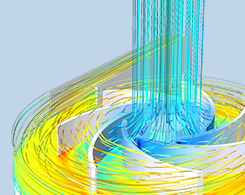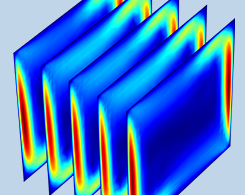Fluid & Heat Blog Posts

Using the Algebraic Multigrid (AMG) Method for Large CFD Simulations
There’s an ideal method for solving large CFD simulations that involve complex geometries. It’s called the algebraic multigrid (AMG) method, and you can learn all about it here.

Keynote Video: Moving Beyond Simulation for Biopharma Applications
At Amgen, researchers build simulation applications for biopharmaceutical uses, such as researching biological and synthetic drugs. Learn more in this blog post featuring their keynote talk.

Using the Inflow Boundary Condition in Nonisothermal Flow Simulations
Nonisothermal flow is a multiphysics problem, as it combines CFD and heat transfer analysis. Learn how to implement the Inflow boundary condition when simulating these types of scenarios.

Modeling Phase Change in a Thermosiphon
A guest blogger from Noumenon Multiphysics writes about modeling phase change in a thermosiphon, a device that has been keeping houses warm since the 1800s.

Advancing Additive Manufacturing with Sequential Simulations
In some ways, additive manufacturing is like sewing or weaving. We talk to a professor of additive manufacturing about how sequential simulations can be used to analyze and optimize the process.

Comparing Static and Dynamic Wall Heat Exchangers with Simulation
We compare the performance and efficiency of static and dynamic compact wall heat exchanger designs using fluid-structure interaction.

Modeling the Flow of Ice in COMSOL Multiphysics®
The dynamics of glaciers are a complex (and “cool”) subject to study. One method is by using fluid flow simulation to analyze the flow of ice, from accumulation to ablation.

Simulating Natural Convection in Air with COMSOL Multiphysics®
From small electronic components to large buildings, natural convection is a transport phenomena found in engineering disciplines of all sizes. Here’s an example of natural convection in air.
